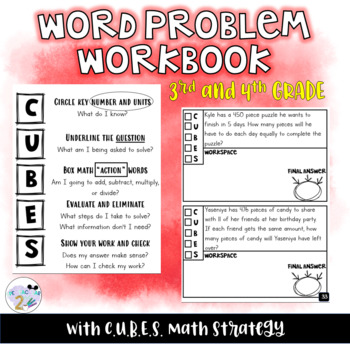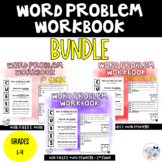Word Problem Workbook- With CUBES Strategy- 3rd & 4th Grade
Spectacular In 2nd Grade
109 Followers
Grade Levels
3rd - 4th, Homeschool
Subjects
Resource Type
Standards
CCSS3.OA.A.1
CCSS3.OA.A.2
CCSS3.OA.A.3
CCSS3.OA.D.8
CCSS4.OA.A.1
Formats Included
- PDF
Pages
52 pages
Spectacular In 2nd Grade
109 Followers
What educators are saying
This set of word problems has worked really well in my classroom. The way that it has been organized has been very helpful.
This resource was really engaging and helpful for my class. My students loved the lesson I used this with.
Also included in
- This Word Problem Workbook BUNDLE is designed for grades 1-4 while using the C.U.B.E.S. math strategy.What is included:1st GradeWorkbook coverTable of contentsCUBES reinforcement stepsAddition/subtraction keywords reference sheet(20 problems)- Single digit addition and subtraction word problems withPrice $13.50Original Price $15.00Save $1.50
Description
This workbook is design for student to solve word problems while using the CUBES strategy. This is for 3rd and 4th grade students, but can be used at the end of 2nd grade for enrichment.
What's Included?
- Workbook covers (3rd and 4th grade)
- Table of contents
- CUBES reinforcement steps
- Addition/subtraction/multiplication/division keywords reference sheet
- (24 problems)-Triple digit addition and subtraction work problems with regrouping
- (12 problems)- Addition and subtraction multi-step word problems
- (14 problems)- Simple multiplication and division word problems
- (20 problems)- Long multiplication and division word problems. Some are multi-step!
- (20 spots)-Blank work space for extra word problems, or write your own!
Total Pages
52 pages
Answer Key
Not Included
Teaching Duration
N/A
Report this resource to TPT
Reported resources will be reviewed by our team. Report this resource to let us know if this resource violates TPT’s content guidelines.
Standards
to see state-specific standards (only available in the US).
CCSS3.OA.A.1
Interpret products of whole numbers, e.g., interpret 5 × 7 as the total number of objects in 5 groups of 7 objects each. For example, describe a context in which a total number of objects can be expressed as 5 × 7.
CCSS3.OA.A.2
Interpret whole-number quotients of whole numbers, e.g., interpret 56 ÷ 8 as the number of objects in each share when 56 objects are partitioned equally into 8 shares, or as a number of shares when 56 objects are partitioned into equal shares of 8 objects each. For example, describe a context in which a number of shares or a number of groups can be expressed as 56 ÷ 8.
CCSS3.OA.A.3
Use multiplication and division within 100 to solve word problems in situations involving equal groups, arrays, and measurement quantities, e.g., by using drawings and equations with a symbol for the unknown number to represent the problem.
CCSS3.OA.D.8
Solve two-step word problems using the four operations. Represent these problems using equations with a letter standing for the unknown quantity. Assess the reasonableness of answers using mental computation and estimation strategies including rounding.
CCSS4.OA.A.1
Interpret a multiplication equation as a comparison, e.g., interpret 35 = 5 × 7 as a statement that 35 is 5 times as many as 7 and 7 times as many as 5. Represent verbal statements of multiplicative comparisons as multiplication equations.



